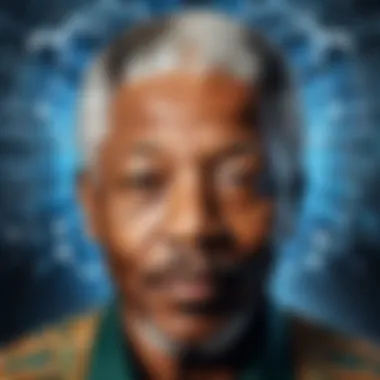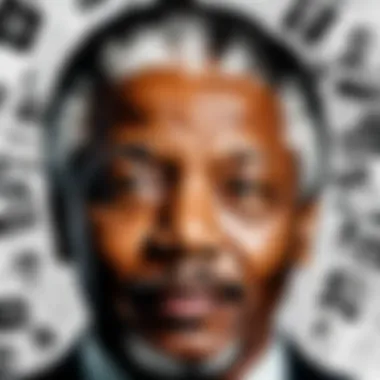Exploring the Various Facets of the Mandela Effect


Intro
The Mandela Effect has become a fascinating topic of discussion, especially in the age of social media. This term describes a situation where a large group of people remember something differently from how it occurred. This phenomenon challenges our understanding of memory and reality. In this article, we will explore various instances of the Mandela Effect, analyzing their origins and psychological implications. This analysis aims to engage readers and provide them with a thorough understanding.
Psychological Implications
Memory is not a perfect recording of events. It is a complex process influenced by various factors. The Mandela Effect sheds light on the collective aspect of memory, which can lead to mass misremembering. This section will explore the cognitive processes involved in such occurrences.
Cognitive Dissonance
When memories conflict, some individuals may experience cognitive dissonance. This discomfort arises from holding two contradictory beliefs at the same time. People often resolve this by reshaping their memories to match those of the larger group. Thus, personal recollections become altered based on social context or group pressure.
Social Identity Theory
Social identity theory posits that an individual’s self-concept is derived from their membership in groups. This phenomenon plays a role in the Mandela Effect. When a group collectively misremembers something, it can solidify group identity. Thus, individuals may align their memories with the group to strengthen their connection.
"Collective memory can shape our understanding of historical events and facts."
Popular Examples
Numerous examples of the Mandela Effect have captured public attention. These instances reveal how collective memory can diverge significantly from historical facts.
The Berenstain Bears
Many people distinctly recall the beloved children's book series as 'Berenstein Bears.' However, the actual spelling is 'Berenstain Bears.' This case illustrates how phonetic similarities can confuse memory.
The Monopoly Man
Another well-known instance involves the Monopoly Man. Many believe he wears a monocle; however, he does not. This misremembering may stem from similar characters in popular culture, merging memories together.
The Location of New Zealand
Some individuals also remember New Zealand being located northeast of Australia. In reality, it lies southeast. This geographical misunderstanding emphasizes how collective misconceptions can arise.
Role of Social Media
In today’s digital age, social media plays a critical role in the spread of the Mandela Effect. Platforms like Facebook and Reddit can amplify discussions around misremembered events. Misleading information can circulate rapidly, causing more individuals to adopt false memories as they engage with shared narratives.
Viral Phenomena
When an instance of the Mandela Effect gains traction online, it often leads to a viral phenomenon. Videos, memes, and posts can influence public perception, reinforcing these altered memories.
End
Understanding the Mandela Effect helps illuminate broader themes of memory, identity, and social influence. By examining its origins and implications, we gain insight into how our minds construct reality. The interplay between personal memory and collective belief is a significant aspect of human cognition. Through this exploration, readers will not only recognize instances of the Mandela Effect but also understand their impact on our perception of truth.
Defining the Mandela Effect
The Mandela Effect is an intriguing phenomenon that evokes curiosity among individuals who explore the nuances of memory in society. Within this exploration, one can recognize how collective misremembering can shape perceptions of reality. The significance of defining the Mandela Effect lies not only in understanding personal memory but also in grasping the implications it poses for societal narratives.
The term itself was coined after Nelson Mandela, as many people erroneously believed he died in prison during the 1980s. In truth, he was released in 1990 and lived until 2013. This initial misremembering sparked discussions about how large groups of people can share the same inaccurate recollections. This section seeks to demystify this effect, as grasping its essence opens pathways to examine related cognitive and psychological insights.
Origins of the Term
The phrase "Mandela Effect" was first popularized in 2009 by Fiona Broome. Her personal discovery of the widespread misconception regarding Mandela's death prompted her to create a website where others shared similar experiences of misremembering. Broome’s efforts helped coalesce the idea into a definable concept.


This notion has since gained popularity, prompting discussions about shared memories across various spheres of society. The origins of the term are essential, as they illustrate the intersection of memory, culture, and collective belief. When naming it after a prominent figure, Broome highlighted how memories are often entwined with broader social narratives.
How It Differs from Other Cognitive Phenomena
The Mandela Effect is distinct from other cognitive phenomena, such as memory distortion or false memories. While both involve inaccuracies in recollection, the Mantela Effect is particularly significant, as it often involves a large number of individuals experiencing the same erroneous memory. This collective nature differentiates it from standard individual memory errors.
Some key differentiators include:
- Scale of Misremembering: Unlike typical memory lapses affecting individuals, the Mandela Effect showcases common false memories shared by numerous people.
- Cultural Context: The phenomenon often reflects cultural narratives, advertising, and media influences, where multiple individuals are subject to the same information.
- Psychological Impact: Understanding the Mandela Effect provides insight into how societal beliefs can shape individual perceptions, revealing layers within cognitive psychology.
The exploration of these aspects paves the way to further delve into notable examples and psychological underpinnings of this phenomenon throughout subsequent sections.
Notable Examples of the Mandela Effect
The examination of notable examples of the Mandela Effect is crucial for understanding the phenomenon. These instances serve not only as illustrations of collective misremembering but also highlight the intricate processes of human memory. By exploring these examples, readers can gain insight into how perceptions can diverge from reality and the factors influencing this divergence. This section offers a closer look at specific and popular instances that have captured public attention, further enhancing our understanding of the Mandela Effect.
The Berenstain Bears vs. The Berenstein Bears
One of the most frequently cited examples of the Mandela Effect is the confusion surrounding the name of the beloved children's book series about the bear family. Many individuals distinctly remember reading "The Berenstein Bears," with the suffix "-stein" being a common ending in American surnames. However, the actual title is "The Berenstain Bears," with the suffix "-stain".
This widespread belief has resulted in vivid discussions, with many claiming that they can recall specific instances of owning merchandise or reading the books under this misnomer. Such collective misremembering may stem from phonetic appeal or cultural familiarity with other similar sounding names. The significance lies in the number of people who share this incorrect memory, pinpointing a curious disconnect between personal recollection and factual accuracy.
The Curious Case of Monopoly Man
Another intriguing example involves the character from the Monopoly board game. The Monopoly Man, also known as Rich Uncle Pennybags, is often remembered as wearing a monocle. However, he has never actually featured a monocle. This misperception raises questions about how visual imagery shapes our memories.
Many who hold the incorrect memory might associate the monocle with the typical portrayal of wealthy individuals in media. This reflects a fascinating intersection of pop culture and memory, demonstrating how societal stereotypes can influence our recollection of even well-known characters. The implications of such misremembering highlight the fluid nature of memory, illustrating that memory can be shaped more by cultural context than by direct experience.
The Sinbad Genie Movie
The alleged existence of a movie starring Sinbad as a genie has become a well-known topic among those discussing the Mandela Effect. Many individuals assert that they remember watching a film titled "Shazaam," featuring Sinbad in a role similar to that of Robin Williams in "Aladdin." However, no such film appears to exist in any official records.
This case introduces an intriguing layer of complexity, as it suggests the potential blending of cultural memories and pop culture references. It raises questions about how memories can become amalgamated over time. In this case, some argue that the memory of the movie may be conflating with other childhood memories or misinterpreted images from media. The profound aspect is not simply the incorrect memory itself, but the shared conviction among many individuals that this movie was part of their experience.
Forrest Gump's Quote Misinterpretations
The 1994 film "Forrest Gump" contains several famous quotes, with one of the most misquoted phrases being, "Life is like a box of chocolates." Many people remember it as, "Life was like a box of chocolates." This minor yet significant alteration showcases how memory can alter not just the words spoken but also the entire tone of the quote.
The shift from present to past tense can influence the way the message is received. It reflects a broader tendency for misquotations to flourish within cultural contexts. The alteration embeds itself into the social consciousness, allowing for the evolution of the phrase beyond its original form. Such misinterpretations showcase the dynamic nature of collective memory, revealing how public perception can reshape well-known expressions over time.
Psychological Underpinnings of Collective Memory
Understanding the psychological aspects of collective memory is crucial to comprehend how the Mandela Effect operates. Collective memory refers to how groups remember events and details shared in their past. It highlights not just the events, but also the processes that shape these memories. By exploring cognitive dissonance, confirmation bias, and memory formation, we can gain insights into why so many people misremember similar details. This can impact a range of areas, from personal relationships to broader societal beliefs.
Cognitive Dissonance and Memory
Cognitive dissonance occurs when there are conflicting beliefs or ideas within an individual. This can lead to mental discomfort, prompting people to adjust their memories or beliefs to reduce this tension. For example, someone might remember a famous event differently because it conflicts with new information they encounter. Instead of accepting the new information, they might alter their memory. This can create a shared sense of remembering things incorrectly, contributing to the Mandela Effect in groups.
The Role of Confirmation Bias
Confirmation bias is a tendency to favor information that confirms existing beliefs or memories. When individuals encounter contradictory evidence, they may dismiss it or reinterpret it to align with what they already believe. This tendency can lead to widespread misremembering, specifically when groups discuss shared memories. If several people recall an event inaccurately but feel validated in their beliefs, it reinforces the misremembered event in their collective consciousness.
How Memory is Formed and Recalled
Memory formation is a complex process involving encoding, storage, and retrieval. When an event occurs, it is encoded into memory through sensory experiences. However, recall is not always straightforward. Memories can be influenced by various factors, including emotion, context, and even social interactions. The more an individual discusses a certain memory, the more it might change over time. Repeated discussions among a group can lead to shared inaccuracies, further embedding the Mandela Effect in a culture or community.
"Memory is not a perfectly accurate recording of events, but rather a reconstruction that can be influenced by numerous factors."


In summary, by exploring cognitive dissonance, confirmation bias, and the mechanics of how memory works, we can begin to understand the psychological foundation of the Mandela Effect. These underpinnings highlight why so many individuals can misremember similar details and events, leading to a collective misperception of their reality.
The Impact of Social Media on Spreading Mandela Effects
The interaction between social media and the Mandela Effect illustrates how information can spread rapidly, influencing public perception. This topic is particularly significant in the context of understanding how collective memories can be manipulated or reshaped through digital platforms. Social media allows for the rapid dissemination of ideas and narratives. It is not simply a tool for communication; it has become a space where shared memories are constructed. This section delves into three main aspects of social media's role in spreading the Mandela Effect: viral memes, online communities, and the influence of digital personalities.
Viral Memes and Their Influence
Memes have emerged as a powerful vehicle for ideas in the digital age. Viral memes often encapsulate sentiments or memories in easily shareable formats, such as images or short videos. When a meme features a misquoted line or a misremembered detail from popular culture, it has the potential to reach millions quickly. For instance, the incorrect memory regarding the Monopoly Man’s appearance can gain traction through an image meme showcasing his supposed monocle. This allows the misconception to circulate widely, as people are more likely to share content that resonates with their experiences of misremembering.
"Memes are not just entertainment; they shape how we view our collective memories."
Such memes not only amuse but also reinforce false memories among viewers. They create a sense of shared experience, even if the shared recollection is inaccurate. Often, the humor created around these misunderstandings adds to their appeal, making people more likely to engage and share further, thus enhancing the reach of the Mandela Effect.
Online Communities and Collective Memory
Online communities play a crucial role in the propagation of the Mandela Effect. Platforms like Reddit and Facebook foster discussions about personal memories and misrememberings. These spaces allow individuals to share their experiences of the Mandela Effect, creating a collective memory that diverges from established facts.
Members may recount their versions of events or details that do not match reality, reinforcing each other's narratives. In groups specifically focused on phenomena like the Mandela Effect, individuals often share anecdotes and explore topics in depth. This process brings validation to shared memories, even when they are inaccurate.
- Communities may:
- Discuss examples of the Mandela Effect.
- Explore personal anecdotes related to specific events or objects.
- Provide support for those experiencing cognitive dissonance related to their memories.
These interactions solidify a shared understanding that can seem more authentic or legitimate than reality. It exemplifies how memory is not static but is constantly shaped and reshaped through social interaction.
The Role of Influencers in Propagation
Influencers have become pivotal in shaping public discourse on social media. Their reach can bridge gaps in understanding, allowing for the spread of ideas—both accurate and inaccurate—across vast audiences. When influencers reference a specific Mandela Effect, they can legitimize the distorted memory for their followers. For example, a popular YouTuber discussing the misquoting of Forrest Gump's famous line can create a wave of renewed interest in that misconception.
Their prominent positions amplify voices that might otherwise remain unheard, thus further propagating Mandela Effects. Perhaps even more concerning is the fact that followers often accept these narratives without critical evaluation, leading to a more entrenched misunderstanding of reality. Influencers can leverage their connection with followers to either challenge these misbeliefs or, conversely, reinforce them based on their own interpretations and experiences.
Cultural and Societal Reflections of the Mandela Effect
The concept of the Mandela Effect offers a unique lens through which we can examine both cultural and societal trends. This phenomenon reveals how collective memory influences our understanding of events, figures, and even objects in popular culture. From history to media, the misrememberings act as a mirror, reflecting our societal values, beliefs, and interactions. Understanding these reflections can enhance our awareness of how we engage with information and the importance of context in interpreting our world.
Historical Misrememberings
Historical misrememberings highlight how society can reshape its collective memories. Events that are widely remembered may vary significantly from what actually transpired. For example, many people incorrectly recall the year of significant historical events or the details surrounding key figures. This can lead to skewed perceptions of history and a lack of critical scrutiny regarding sources of information.
One such example includes the widespread belief that Nelson Mandela died in the 1980s while he was still in prison. This misconception influenced the naming of the Mandela Effect itself, as it encapsulates the often flawed collective memory that many share. Historical misremembering can serve as a gateway to larger narratives about nationalism and cultural identity. It raises questions about how history is taught and understood. When a significant portion of the population recalls events inaccurately, it casts doubt on the reliability of historical education and media.
Influence on Pop Culture and Media
The impact of the Mandela Effect on pop culture and media is profound. It not only informs entertainment choices but shapes trends and discussions across platforms. When individuals misremember quotes, movies, and even character names, it fosters a dialogue about memory, culture, and the nature of narratives.
For instance, the belief that the Monopoly Man wears a monocle is a common error, yet this fictional detail has become part of the cultural lexicon. Similarly, misquotes from films, like "Luke, I am your father" from Star Wars, continue to percolate through discussions and debates. These examples illustrate how the misremembering can perpetuate stereotypes and influence how stories are shared and retold.
The rise of social media amplifies this effect. Viral memes and content often rely on these misremembered elements to gain traction, thus cementing them further in the public consciousness. Platforms like Facebook and Reddit serve as repositories for these collective memories, enabling the propagation of misremembered details to wider audiences.
In summary, the cultural and societal reflections of the Mandela Effect encompass a complex interplay between memory and identity. By exploring historical misrememberings and their influence on pop culture and media, we can gain insights into how collective memory shapes our understanding of reality.
Scientific Explanations for the Mandela Effect
Understanding the Mandela Effect involves delving into the scientific explanations behind it. This phenomenon does not only intrigue the general public but also serves as a substantial topic for psychologists and neuroscientists alike. By exploring the cognitive processes that lead to collective misremembering, we can better appreciate how memory and perception work. This section will cover the neuroscience of memory and theorize about the possibility of parallel universes, offering insights into how these elements contribute to the Mandela Effect.


Neuroscience of Memory
Memory is a complex function of the brain, involving various regions and processes. Each time we recall something, we reconstruct that memory, which can lead to alterations in the details. Research indicates that these memory reconstructions can be influenced by external factors.
- Encoding: The way we initially encode information influences how we remember it later. This process is not perfect, and mistakes can occur, leading to variations in how we recall events.
- Storage: Memories are stored in neural pathways. These pathways can weaken over time, leading to gaps in our recollection. When we attempt to retrieve a memory, we may unintentionally fill in these gaps with incorrect details or even details from other sources.
- Retrieval: During the retrieval phase, we may be influenced by social cues or misinformation. The phrase "misinformation effect" describes how exposure to incorrect information can lead to distorted memories.
Neuroscience shows that memory has its limitations. This helps explain why large groups may misremember the same details. Neural mechanisms can create an illusion of memory accuracy when, in fact, misinterpretations dominate.
Theories of Parallel Universes
Theories suggesting that the Mandela Effect may be evidence of parallel universes raise fascinating questions about reality. Some propose that when individuals experience conflicting memories, they might be referencing experiences from alternate timelines or realities. This theory can be enticing, albeit controversial.
- Quantum Mechanics: Some interpretations of quantum mechanics support the idea of multiple realities. When applied to the Mandela Effect, this perspective posits that shifts between these realities could explain collective misremembering.
- Multiverse Theory: This theory suggests that for every decision, a branching universe may exist. If true, people could, in theory, slip into different universes, where historical facts differ in subtle ways, which might cause discrepancies in memories.
While these theories are not scientifically proven, they stimulate thought-provoking discussions. They challenge conventional perspectives of time and reality.
"The Mandela Effect is a reminder of the complexities inherent in human memory and perception. It compels us to question the very fabric of our experiences and beliefs."
In summary, the scientific explanations of the Mandela Effect demonstrate the intricate interplay between memory, perception, and potentially alternate realities. Both neuroscience and speculative theories contribute to a deeper understanding of how human cognition operates and why collective misremembering occurs.
Instances of the Mandela Effect in Everyday Life
The exploration of instances of the Mandela Effect within the framework of everyday life highlights the pervasive nature of collective memory errors. It serves as an important reminder of how shared experiences, or misrememberings, can shape individual perceptions and societal norms. Understanding these instances sheds light on our cognitive processes and how they influence interactions, decisions, and even cultural trends.
Personal Anecdotes and Shared Experiences
Individual stories about the Mandela Effect provide powerful insights into its presence in our daily lives. Many people share experiences where they recall an event or detail distinctly, only to find that others perceive that same memory differently. This not only creates a fascinating dialogue about the reliability of memory but also emphasizes the idea of shared reality.
For instance, a common example involves the song "We Are the Champions" by Queen. Many listeners believe it ends with the phrase "of the world," yet in various versions of the song, this line appears only at times during performances. Many individuals insist they remember it this way, emphasizing their shared memories despite the testimony of actual recordings. This generates communal discussions and can extend to friendships or social circles, where individuals often bond over their differing recollections.
The sharing of these anecdotes serves as a reflection of the complexities inherent in human memory. Gathering these narratives can also foster a sense of belonging and connection amid the discrepancies.
Impacts on Consumer Products and Branding
The Mandela Effect also finds significant relevance in the realm of consumer products and branding. Marketers and companies often navigate customer perceptions shaped by collective memories. In some cases, well-documented misrememberings can lead to intensified brand loyalty or confusion, depending on the context.
For example, the popular candy, Skittles, has been associated with a variety of slogans and advertising campaigns. Many consumers strongly recall specific taglines that never existed. This propensity for misremembering can affect buyer preferences. If a consumer feels nostalgic for a slogan they never actually encountered, it may influence their purchasing behavior.
Furthermore, branding tied closely to cultural eras can witness shifts in public perception influenced by the Mandela Effect. An example includes the branding of the well-known movie studio, Pixar. People often mistakenly recall the logo as having a blue background, while it actually spans a yellow design. This misperception can manifest in a variety of contexts—fan discussions, merchandise design, and promotional materials, leading to both miscommunication and brand reevaluations.
Ultimately, understanding these elements proves crucial in addressing the implications the Mandela Effect has on daily life. Small changes in collective memory can ripple through various facets of society, impacting everything from social interactions to economic dynamics.
Future Implications of Recognizing the Mandela Effect
The Mandela Effect signifies more than just intriguing shared misrememberings; it has significant future implications that require close attention. Recognizing this phenomenon can shape how society perceives information, influences communication styles, and alters educational approaches. Understanding the broader impact is important for tech-savvy individuals and educators.
Potential for Miscommunication
Miscommunication often arises when people possess different memories of events or details. The Mandela Effect can contribute to this phenomenon because large groups may share incorrect information. For instance, the famous line from the movie Forrest Gump is commonly misquoted, leading to confusion about the character's actual words. This potential for miscommunication affects interpersonal relationships and even professional environments.
When discussing ideas or sharing knowledge, these misremembered details can easily morph into misunderstandings. For companies and brands, this becomes crucial. They must ensure clarity in messaging to avoid misrepresentation of products or services. More importantly, fostering environments where individuals can clarify doubts effectively could mitigate risks associated with these shared false memories.
"Understanding the implications of the Mandela Effect can lead to more effective communication strategies and help build better relationships."
Impacts on Education and Learning
In educational settings, the Mandela Effect has substantial ramifications. If students collectively misremember facts, this can lead to flawed knowledge foundations. For instance, history classes may feature misconceptions about significant events or figures. This presents a challenge for instructors to address these inaccuracies while teaching.
Moreover, with the proliferation of digital information, educators should employ strategies that emphasize critical thinking and accurate recall in students. Techniques, like collaborative discussions and fact-checking behaviors, can enable learners to navigate the complexities of collective memory.
The integration of technology in learning can also create nuances in how information is processed. Utilizing platforms like Reddit for discussion forums allows students to engage with diverse viewpoints. However, educators must encourage fact-based analysis continually.
In summary, recognizing the Mandela Effect can reshape communication paradigms and educational frameworks. Addressing its implications helps cultivate more informed individuals who approach information with a critical mindset.







